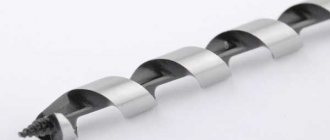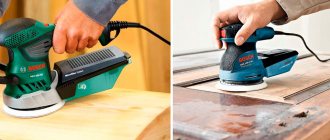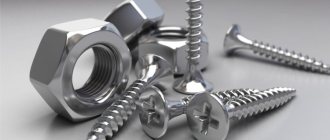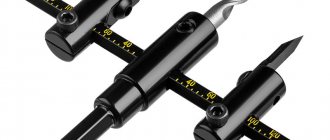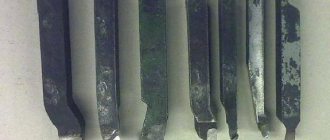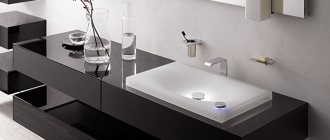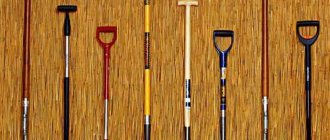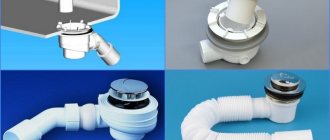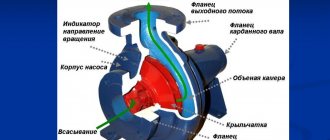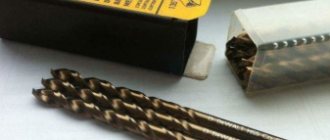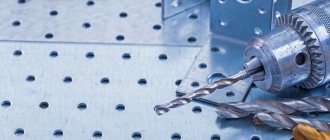Twist drill
This is the most popular type of tool that is found in every workshop. The drill has a screw design and a spike located in the middle.
For carpentry work, you need to purchase a set that contains 8 drills. Parameters from 3 to 10 mm. The cost of a basic set of drills is about 150 rubles.
To begin with, you can use the cheapest models, and then purchase drills that work for a long time without sharpening. A screw or twist drill is suitable for holes that do not go all the way through; they leave a flat bottom, which is not always practical.
A nuance of using the equipment can be considered that such drills practically do not remove chips. If it is necessary to make a hole with a decent depth, this is done by several immersions of the device in the raw material.
Do not confuse a twist drill with a Lewis twist drill.
Wood drills: types, design features and applications
For high-quality performance of even such a simple procedure as drilling holes in wood products, the correct mode and the appropriate tool are required.
When choosing a wood drill, you should take into account the characteristics of both the material being processed and the hole that needs to be made.
The modern market offers a wide variety of drills designed for making holes in wood, so choosing a tool to solve certain technological problems will not be any particular problem.
Drilling holes for socket boxes with a core drill in wood
Main types
The main parameter, depending on which wood drills are divided into different types, is the design of the working part. Based on this feature, wood drilling tools may fall into one of the following categories.
Feather
Drills of this type are used to make holes of medium diameter in wood - up to 25 mm. It is advisable to use such a tool in cases where the requirements for the accuracy of geometric parameters, as well as for the quality of the holes, are not too strict. Among the most significant advantages of pen drills, low cost and ease of maintenance should be noted.
Feather drills are considered the most affordable
Crowned
Core type tools are designed for drilling large diameter holes. In terms of their design, wood crowns resemble a metal glass with a shank, the working end of which has cutting teeth. When such a drill rotates, its cutting teeth, interacting with the workpiece, cut out a circle of the required diameter on its surface.
Set of wood crowns
Spiral
Spiral wood drills are also called screw drills. Their working part resembles a screw. They are used for drilling small diameter holes in wood.
Due to the special design of screw-type drills, chips are effectively removed from the processing area when used.
The twist drill also ensures high precision and extremely high quality machining.
Spiral wood drill with scoring bits
Forstner drills
These are tools with the help of which, in products made of wood, they create not through, but blind holes with a perfectly flat bottom. In addition, if you use such a wood drill with additional accessories, you can drill a square hole in a wooden product.
There are many modifications of the Forstner drill available.
Milling
With the help of such tools, it is possible not only to drill wood, but also to make grooves of various configurations in wood products. Drills of this type are most often used in cases where it is necessary to perform complex processing of wooden parts, and in order to drill a regular hole, a twist drill, a feather or a core tool is used.
Milling drills are designed for drilling a round hole and then boring it to the desired shape. Used when working with wood and thin metal
The shank of drills designed for woodworking is usually cylindrical, but manufacturers also produce them with shanks of other configurations. So, on the modern market you can buy drills for woodworking, the shanks of which can be:
- triangular, optimally suited for fixation in a three-jaw chuck (tools with a triangular shank are ideally transmitted torque, and even very significant loads are not able to turn it in the chuck);
- hexagonal (tools with such shanks can be installed in both a standard and a three-jaw chuck, but there is a very high risk of the drill turning when subjected to heavy loads);
- conical (tools with shanks of this type are used primarily to equip production equipment);
- tetrahedral (a rarely used form of shanks, which, however, ensures high stability of the tool against rotation in the chuck).
Areas of use and design features
As mentioned above, in order to drill a quality piece of wood, it is very important to choose the right drill bit.
When making this choice, it is necessary to take into account both the characteristics of the material being processed (in particular, its hardness) and the type of hole that needs to be made.
That is why it is very important for home craftsmen and specialists whose work involves processing wooden blanks to understand both the types and functionality of wood drills.
Twist (screw) drills
A twist or screw drill can be produced with two types of working tips: conical and with special scoring tips. If we compare both types according to the degree of their effectiveness, then it is almost at the same level.
However, they differ in the load taken by the tool during wood processing. Thus, in the design of the working head of a drill with a scoring tool, there is a jumper, which causes significant loads to be transmitted to the entire body of the tool.
Drills with a conical working head do not have this drawback, which, in addition, are much better centered on the surface of the workpiece. The conical head immediately enters the material, and the drill does not move to the side.
Meanwhile, spiral drills with scoring tools, due to their design features, allow you to create holes in wood with higher precision.
Design of a twist drill for wood
Drilling wood using a spiral tool allows you to get precise and neat holes with straight edges and a smooth surface on the inner walls.
Tools of this type can be used for drilling wood of any species and almost any hardness, as well as materials made on its basis (chipboard, MDF, plywood, etc.).
If the drill is driven into the material being processed at a low speed, there will be no need to frequently remove the tool from the hole being created to remove accumulated chips.
Spiral drills for wood are made of two types: 1 – with a wide ribbon; 2 – with a narrow ribbon
When designing and manufacturing screw drills, much attention is paid to their geometric parameters. This, in particular, includes the angle of inclination of the helical groove, as well as the ratio of the dimensions of the elements of the working part in the cross section.
The angle of inclination of the helical groove and the degree of roughness of its working surface influence the efficiency of chip removal during processing. The cross-sectional geometry of the working part determines the strength characteristics of the drill.
Geometric parameters of twist drills for wood
The most vulnerable from the point of view of breakdowns are long wood drills, the diameter of which does not exceed 3 mm. The risk of breakage increases with incorrect selection of drilling modes, as well as careless use of the tool.
All long wood drills should be handled with great care.
A long drill, the cross-section of which can be any size, is used to create holes whose depth is 20–30 times their diameter.
The category of spiral drills also includes Lewis auger drills, used to make deep holes of significant diameter in wood. The structural elements that make up such an auger drill are a massive spiral (auger) encircling the central rod of the tool.
Lewis drill design
In order for such a drill to plunge into the material being processed at a given point, its working part has a threaded tip.
Since the outer surface of the screw is machined to a mirror finish, the inner walls of the hole being made are also perfectly smooth.
Another distinctive feature of the design of this woodworking tool is the small angle of inclination of the groove, through which chips are removed from the processing area.
Auger drill for wood with central rod
Spiral type tools designed for drilling wood are available in a wide range of working diameters.
If you need to drill large-diameter holes, you should carefully select the equipment with which the drill will be used.
In these cases, it is necessary to use a low-speed device, and not a conventional drill, which is not designed to work with large-diameter tools.
Feather type drills
To make deep holes of large diameter, the dimensional accuracy and quality of which are not too demanding, you can use inexpensive pen-type drills. They are produced in the range of diameters 10–60 mm and various (including significant) lengths.
If the length of the feather drill is not enough to make a deep hole in the tree, it can be increased using a special extension.
However, when using such a device, which allows you to increase the processing depth by another 30 cm, extreme care should be taken, since the junction of the tool and the extension is not very rigid.
An adjustable flat-milling drill is also classified as a feather drill.
When drilling holes in wood using feather drills, you should also not apply strong pressure to the tool, which is a rather fragile structure.
Flexible drills
It should be said right away that experts have not yet invented flexible drills, and this term does not quite correctly designate flexible shafts, which, in fact, are only a drive mechanism that transmits torque from the equipment chuck to the tool.
Using a flexible shaft in combination with an electric drill, screwdriver and drill allows you to make holes even in the most difficult to reach places.
The flexible shaft can only be used with drills of small and medium diameter; such a device is not intended for massive tools.
Perhaps the only attachment that fits the term “flexible drill” can be called a device for drilling holes when installing communications inside partitions
From all of the above, it becomes clear that today there are many types of tools that allow you to successfully drill holes in wood products. That is why you can select the right wood drills to solve a specific technological problem only if you understand their design features and functionality.
Source: https://met-all.org/oborudovanie/prochee/sverlo-po-derevu-spiralnoe-bolshogo-diametra-dlinnoe-vintovoe.html
Flat drill: features and characteristics
The tool has another name, it is called a feather drill. In addition to the central tenon, the drill has scoring edges and a different configuration. If you look at the first drill and the screw drill, you will immediately see the differences.
The tool is used to make through and non-through holes that have a shallow depth. For carpentry work, a set of 6 pieces is suitable, the parameters of consumables are from 10 to 25 mm in diameter.
Types of products and their features
Let's look at what options you can find in our retail network and how they differ from each other.
Feather drills
The most common and budget option, which is quite convenient for even inexperienced craftsmen to work with. And you can also master this simple process with your own hands.
Let's look at the main advantages of this solution:
- The diameter range varies from 10 to 60 mm.
- The work is done quite quickly, but the quality of the hole is low, and it is unlikely to achieve an ideal result.
- The maximum drilling depth is approximately 150 mm.
- Products are sold either in sets of 5-6 pieces or individually, so you decide which option is right for you.
- If necessary, you can buy an extension that clamps the drill and increases its length by 300 mm.
Large sizes are usually sold individually, small sizes are usually sold in sets.
It is impossible not to mention such an interesting option as an adjustable pen drill; this type of product can make holes with a diameter of 22 to 76 mm. The work is carried out at low speeds using fairly powerful power tools.
Adjustable nib – a new word in products of this type
Forstner drill
This product option is used very widely in furniture production due to a number of undoubted advantages:
- The edges of the hole are perfectly smooth, which is not possible with other options.
- High reliability and long service life allow such devices to be used for years.
Massive nodes are very reliable
- The size range varies from 10 to 60 mm.
- The standard drilling depth is about 10 cm, but if desired, you can additionally purchase a 300 mm extension.
- This is the only option with which you can drill blind holes, because the centering pin protrudes only a couple of millimeters.
Screw drills
This option is very popular among those who drill large-diameter holes in wood to a considerable depth. To use them, you don’t need special instructions; just connect the unit to the power tool and you can start working.
The features include the following:
Spiral fixtures are available in a wide range of sizes
- This option is available in three lengths: 220, 450 and 600 mm. The last type is the most popular, since it can be used to effectively drill thick materials.
- It is best to use a drill with a rotation speed of 800 rpm. This allows you to carry out work most efficiently, but at the same time the power indicators of the power tool must be high.
- If you need to drill holes in log houses through 2-3 logs, then you shouldn’t even consider other options; this solution is optimal in all respects.
- The hexagonal shank allows you to securely fix the unit in the drill chuck.
All craftsmen who build log houses use this option.
Circular adjustable designs
The popular name for this device is wood ballerina. The design is a kind of compass, in the middle of which there is a centering drill, and cutting elements move on the crossbar, which can be installed in different positions.
The following factors can be considered features of this solution:
- With its help it is very good to process sheet materials and products up to 20 mm thick. The design copes well with both wood and fiberboard, chipboard, plywood and other similar options.
- The range of possible hole diameters is quite wide and ranges from 30 to 130 mm. This is much more than all the options described above, and the only drawback can be considered the small processing depth.
- The kit should include a hex wrench for adjusting the position of the cutting units and a center punch for making marks on the surface. It is recommended to carry out work at low speeds, since during the drilling process the cutting elements are subjected to very strong loads and can simply break.
This is what ballerinas look like when working with wood
Important! You can find many fakes on sale that are short-lived and do a poor job, so you should be especially careful and scrupulous when choosing this option (see also the video in this article).
How to drill a hole in a large diameter tree? Read about it below.
Hole drills for wood
The second name for devices of this kind is tree crowns; they are widely used due to a number of advantages:
- Possibility of drilling diameters from 19 to 127 mm, you will not have a question about how to drill a large hole in wood, the work will be simple and fast.
- Products are sold in sets of 12 or 6 pieces, allowing you to have a wide range of accessories on hand for all occasions. Of course, the cost of such a set will be quite impressive, but you will once and for all solve the problem with devices for creating large holes in wooden structures.
Forstner drill
The tool is intended for making loops, belongs to specific equipment and is not widely used.
The design of the drill resembles a feather analogue, but has uneven edges. This consumable allows you to get a hole that has a flat bottom and edges, allowing you to install hinges without additional modification.
One such tool is sufficient, but it is precisely the diameter that these loops should be. To create standard hinges, the drill must have a diameter of 35 mm, for non-standard ones – 26 mm.
How to drill a long hole in wood
All photos from the article
If you need to make a large diameter hole in a tree, you will have to use special devices, each of which has its own characteristics. We will consider all possible options and tell you about their main advantages and disadvantages so that you can choose the best option in accordance with the specifics of the work in a given situation.
In the photo: equipment for wood differs from equipment for concrete and ceramics
How to drill wood?
For quality work, it is enough to follow a few recommendations:
- Accurate markings. In order for the holes to be in the right place, it is necessary to make preliminary markings.
- If you need to make a through hole, first use a small drill, then drill the workpiece with a large drill. This method will avoid chipping.
- For blind holes, tape is wound around the drill from the desired edge.
Woodworking requires high-quality tools and adherence to technology. With a good tool, drilling into wood is easy.
Wood ballerina: adjustable drill or how to make a large hole
Often when working with wood and wood-based materials, it becomes necessary to drill an even round hole. You can use a jigsaw or a router, but such a tool is not always at hand or it is simply inconvenient to do the work with them. A woodworking ballerina can make the task easier.
What is a wood ballerina
A circular adjustable ballerina drill is a device that is designed for drilling round holes of large diameter. The tool has a simple design.
It consists of a shank with a transverse rod on which movable carriages with cutters are attached. The rod has markings according to which you can set the required spread of the cutters relative to the center of the intended hole.
A core drill is fixed in the middle of the shank. It serves as a centering element and support when drilling.
In addition to designs with two cutting elements located symmetrically, there are ballerinas with one cutter or even three. In the latter case, they are located on the base in the form of a disk with grooves.
Tool functionality
A high-quality ballerina is made of high-strength steel, which makes it possible to use the device in working with soft and hard wood.
This tool has an adjustable drilling diameter. This allows you to make holes of almost any diameter. The limitation of the drilling range depends on the size of the ballerina. Manufacturers produce devices with the following cutter spread limits:
- from 30 to 120 mm;
- from 40 to 200 mm;
- from 40 to 300 mm;
- from 40 to 400 mm.
The maximum drilling diameter is limited by the rod on which the cutters are mounted. The minimum is the thickness of the shank.
A ballerina drill can be used in any places where using a jigsaw or a hand router would be inconvenient.
For example, this may be assembled and installed furniture, in the part of which it is necessary to drill a neat hole, given the limited space. Another example is an uneven (concave or curved) surface.
It’s unlikely that you’ll be able to do everything smoothly and neatly with a jigsaw or milling cutter. It will be difficult to control the inclination of the tool relative to the surface. A ballerina can easily cope with this task.
Features of working with the tool
The principle of working with a circular drill is simple. A hole is drilled using a centering drill, and then the cutters are put to work. They gradually make a narrow groove, gradually cutting through the material in a circle to the full depth.
The materials used in working with the ballerina are varied: wood, fiberboard, chipboard, MDF, plasterboard, plastic. One common point is that the thickness of the part should be no more than 15-20 millimeters. This parameter is limited by the length of the incisors. Usually the manufacturer indicates the maximum drilling depth on the packaging. If you try to drill into thicker material, you may experience problems with ragged edges.
The use of a tool with one cutter is characterized by runout. This is caused by a lack of balancing relative to the longitudinal axis of the drill. The beating will be especially noticeable when cutting large diameter holes. Cut holes using a drill at low or medium speed. When working on a drilling machine, such problems do not arise.
Also, a laminated or veneered surface can cause inconvenience when working. After passing through the decorative layer, drilling proceeds without problems.
A feature of the circular drill can be considered the ability to adjust the diameter. The distance between the cutters can be set using a scale on a rod or more accurately using a caliper. This is convenient if you need to make a hole without gaps for a pipe or round part.
The spacing of the cutters relative to the center is adjusted individually. It is necessary to align the cutting parts as accurately as possible. This will eliminate unnecessary effort during operation and extend the life of the tool.
How to choose and what to pay attention to
Choosing a high-quality circular drill is quite easy. The main thing is to know the main points that you should pay attention to first, but also not to lose sight of the little things.
The design is a very important point: a wood ballerina comes with one chisel or two or more. For frequent use, it is better to purchase an option with two or three cutting elements. It is easier to work with such devices and the quality of the processing performed will be at an acceptable level.
It would not be superfluous to be able to replace individual parts. Inexpensive circle drills can have a solid shank with a permanent center drill and rod.
Metal, its quality determines its strength and ability to withstand workloads. High-quality tools are made from high-strength steel or alloys. The shank and cutter holders are shaped using a machine tool. The rod is usually stamped and made of the same metal.
Cheap options often use soft metal or alloys, which can be brittle. Under load, parts may become deformed or break. Such a tool will not last long and it will also be difficult to achieve accuracy from it.
The quality of workmanship, the main feature is the absence of backlashes and distortions. All parts must fit together and be securely fastened with fixing screws.
The markings of a high-quality ballerina's barbell are stamped. Sometimes the divisions are highlighted with bright paint for better visibility.
Cutters and high-quality cutting elements are made from hardened tool steel. They are secured to the holders with rivets or soldering. Solid cutters with holders (made of the same metal) quickly become dull and are not durable.
Manufacturer, when choosing any tool and consumables, preference should be given to well-known and long-proven brands and brands. The most common are Topfix, Stayer, Irwin, Strum.
Purchasing an adjustable circular drill for use at home, or if you need to drill several holes, is completely worth it. This eliminates the need to purchase an expensive tool that may only be needed a few times.
Source: https://prosto-instrumenty.ru/balerinka-po-derevu-reguliruemoe-sverlo-ili-kak-sdelat-bolshoe-otverstie/
Helpful tips when drilling holes
Here are some tips from professionals that will surely help you when drilling holes in wood:
a) for vertical drilling, you can install a square parallel to the drill; b) if you often have to do carpentry work, purchase a special stand for a drill, which allows you to hold the tool strictly vertically and controls the depth of the holes; c) be sure to use a vice when drilling to avoid splitting the wood; d) so that the outlet hole does not have chips, place an unnecessary block under the wooden part and drill them together. This is especially applicable when making holes in a thin board; e) if you do not have a drilling depth limiter, wrap the drill in the area of limitation with bright electrical tape or masking tape.
